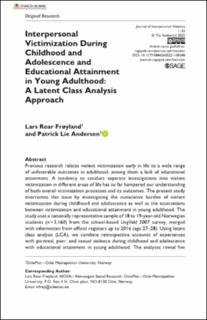| dc.description.abstract | Previous research relates violent victimization early in life to a wide range
of unfavorable outcomes in adulthood, among them a lack of educational
attainment. A tendency to conduct separate investigations into violent
victimization in different areas of life has so far hampered our understanding
of both overall victimization processes and its outcomes. The present study
overcomes this issue by investigating the cumulative burden of violent
victimization during childhood and adolescence as well as the associations
between victimization and educational attainment in young adulthood. The
study uses a nationally representative sample of 18 to 19-year-old Norwegian
students (n = 3,160) from the school-based UngVold 2007 survey, merged
with information from official registers up to 2016 (age 27–28). Using latent
class analysis (LCA), we combine retrospective accounts of experiences
with parental, peer, and sexual violence during childhood and adolescence
with educational attainment in young adulthood. The analyses reveal five
classes of violent victimization: (1) non-victims (55.7%), (2) peer victims
(16.6%), (3) victims of parental violence (14.5%), (4) victims witnessing
domestic violence (5.6%), and (5) polyvictims (experiencing parental, peer,
and/or sexual violence: 7.6%). They also show lower educational attainment
in all groups reporting victimization through physical contact compared to
non-victims, particularly among peer victims and polyvictims. Violence thus
seems to impair educational attainment for a large share of the population.
The identification of particularly lower education among the polyvictims also
show the importance of considering the cumulative burden of violence when
deciding on treatment needs and the design of help services for victims. | en_US |

